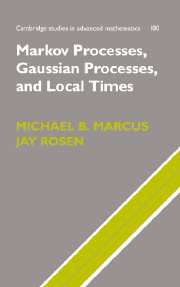Book contents
- Frontmatter
- Contents
- 1 Introduction
- 2 Brownian motion and Ray–Knight Theorems
- 3 Markov processes and local times
- 4 Constructing Markov processes
- 5 Basic properties of Gaussian processes
- 6 Continuity and boundedness of Gaussian processes
- 7 Moduli of continuity for Gaussian processes
- 8 Isomorphism Theorems
- 9 Sample path properties of local times
- 10 p-variation
- 11 Most visited sites of symmetric stable processes
- 12 Local times of diffusions
- 13 Associated Gaussian processes
- 14 Appendix
- References
- Index of notation
- Author index
- Subject index
4 - Constructing Markov processes
Published online by Cambridge University Press: 24 February 2010
- Frontmatter
- Contents
- 1 Introduction
- 2 Brownian motion and Ray–Knight Theorems
- 3 Markov processes and local times
- 4 Constructing Markov processes
- 5 Basic properties of Gaussian processes
- 6 Continuity and boundedness of Gaussian processes
- 7 Moduli of continuity for Gaussian processes
- 8 Isomorphism Theorems
- 9 Sample path properties of local times
- 10 p-variation
- 11 Most visited sites of symmetric stable processes
- 12 Local times of diffusions
- 13 Associated Gaussian processes
- 14 Appendix
- References
- Index of notation
- Author index
- Subject index
Summary
So far in this book, we have simply assumed that we are given a strongly symmetric Borel right process with continuous α-potential densities uα(x, y), α > 0 and also u(x, y) when the 0-potential exists. In general, constructing such processes is not trivial. However, given additional conditions on transition semigroups or potentials, we can construct special classes of Borel right processes. In this chapter we show how to construct Feller and Lévy processes. (For references to the general question of establishing the existence of Borel right processes, see Section 3.11.) In Sections 4.7–4.8, we show how to construct certain strongly symmetric right continuous processes with continuous α-potential densities that generalize the notion of Borel right processes and are used in Chapter 13.
In Sections 4.4–4.5 we present certain material, on quasi left continuity and killing at a terminal time, which is of interest in its own right and is needed for Sections 4.7–4.10. In Section 4.6 we tie up a loose end by showing that if a strongly symmetric Borel right process has a jointly continuous local time, then the potential densities {uα(x, y), (x, y) ∈ S × S} are continuous.
In Section 4.10 we present an extension theorem of general interest which is needed for Chapter 13.
Feller processes
A Feller process is a Borel right process with transition semigroup {Pt; t ≥ 0} such that, for each t ≥ 0, Pt : C0(S) ↦ C0(S). Such a semigroup is called a Feller semigroup. We consider C0(S) as a Banach space in the uniform or sup norm, that is, ∥f∥ = supx ∈ S |f(x)|.
- Type
- Chapter
- Information
- Markov Processes, Gaussian Processes, and Local Times , pp. 121 - 188Publisher: Cambridge University PressPrint publication year: 2006



